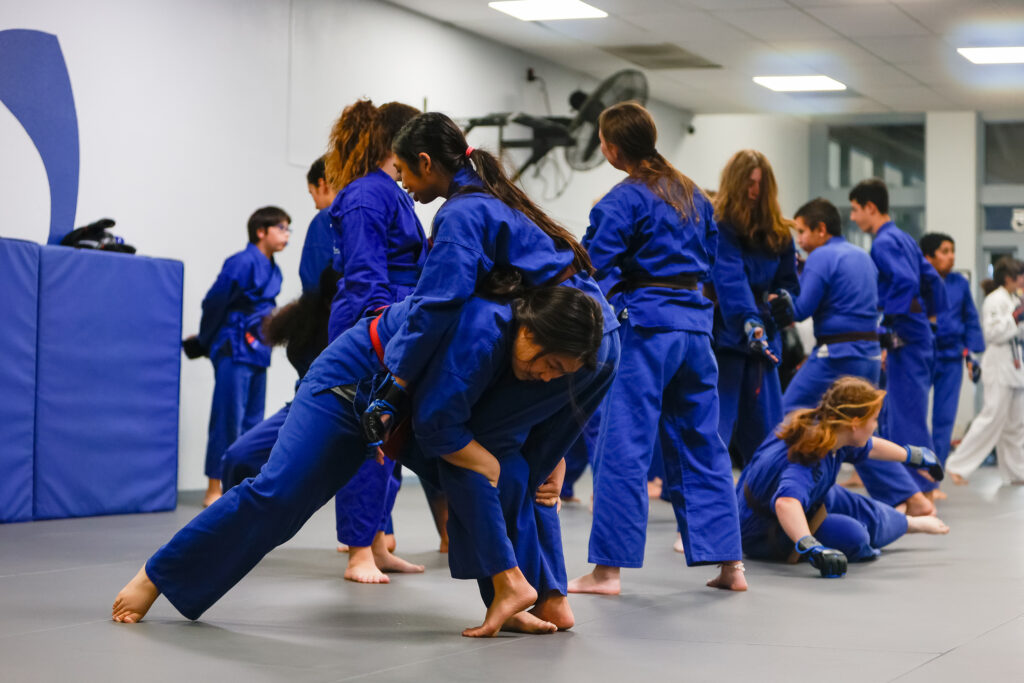Grappling focuses on takedowns, submissions, and ground fighting instead of using weapons or strikes. It is also the third module in the SwiftKick Module Method. In competitions, the winner may be determined by their ability to establish and maintain dominance during the match instead of a clear winner when one opponent surrenders. Understanding some of the common techniques in grappling gives insight into the value and purpose of this module in the SwiftKick curriculum.
Stand Up and Ground Grappling
If you picture any martial arts match, they usually begin with stand-up grappling. Stand-up grappling is integral as opponents begin combat in standing positions. Stand-up grappling is considered offensive and defensive because of the skills to keep opponents out of strike distance in defense and draw them into striking distance in an offensive move. Stand-up grappling often ends in takedowns and throws, with at least one opponent ultimately on the ground.
Ground grappling occurs once opponents are no longer standing. The goal on the ground is to maintain a dominant position over the opponent. However, skilled ground grapplers may prefer to be in an inferior position and find it easier to escape because the opponent becomes exhausted, keeping them in a pinned position.
Take Downs
In a takedown, one grappler knocks their opponent to the ground from standing and puts them in a dominant position.
Throws
A throw-in is when a grappler lifts an opponent or takes them off balance, and they go from the air to the ground. Depending on the style, some throws will leave the grappler standing over their opponent, while other throw techniques end with both opponents on the ground and one in the controlling position.
Submissions
There are two common holds in grappling called submissions. These two holds can cause serious damage and injury outside of controlled sparring and competitions. Once an opponent is unable to escape a choke or lock hold, they must tap their opponent to let them know they submit.
Escapes
When an opponent in an inferior position is able to maneuver out of a position of submission successfully or is able to stand after being on the ground, the immediate danger of being in a submission hold is removed.
Pins
Controlling pins keep opponents on their backs, unable to attack. Some martial arts styles consider a pin an instant victory, whereas others only award points for achieving this in a match.
Sprawling
Sprawling is a defensive response to an opponent trying to take another to the ground. The legs shift backward and spread out in one motion, flipping the opponent and shifting the dominant position.
Why is Grappling Important?
At SwiftKick, grappling is the most immersive and close-contact element in training. This module teaches and practices skills, allowing students to neutralize an opponent and grapple in close contact and on the ground.
Grappling techniques are incorporated, pulling from styles that include Brazilian Jiu-Jitsu, MMA, Muay Thai, and Wrestling. These techniques give students the upper hand and knowledge when a confrontation goes to the ground. In essence, wrestling is grappling standing up and then grappling on the ground for points in competitions. However, in real-life situations, students must learn to use their skills and breathing techniques to overcome a physically dominant opponent and leverage technique over strength on the ground.
Don’t Neutralize, Dominate in Grappling
Most people in a situation where they are being attacked will try to hold an attacker still to slow down what is happening. This approach is not only exhausting but ineffective. Instead, when martial arts students learn to use the force against them to take the attacker down to the ground, where they have a better chance of landing a strike or escaping, it is much better in self-defense.
The Grappling Module is a necessary and valuable element to the complete martial arts training experience. Young children gain confidence through grappling in a controlled and supervised environment as they realize they can defend against an aggressor. Grappling teaches all students awareness of their bodies, efforts, and control. Self-defense allows students to experience what it feels like to break away from a pin or hold and practice escapes that can be lifesaving.
SwiftKick programs are designed to bring quality self-defense training that blends many styles of martial arts. Children and adults can learn self-defense and work through different modules to equip themselves with the skills necessary to protect and defend. Although martial arts do not promote aggression, it is important for everyone to recognize they can take an active role in a situation where they are threatened and in danger. Contact SwiftKick today and come in for a free training class!

